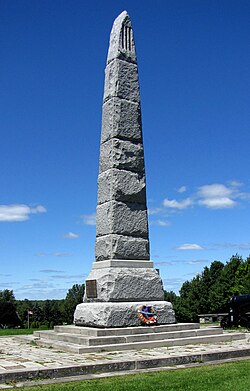Battle of Crysler's Farm
| Battle of Crysler's Farm | |||||||
|---|---|---|---|---|---|---|---|
| Part of War of 1812 | |||||||
 Monument to battle erected near Upper Canada Village |
|||||||
|
|||||||
| Belligerents | |||||||
|
|
|
||||||
| Commanders and leaders | |||||||
|
William Mulcaster Joseph W. Morrison |
James Wilkinson John Parker Boyd Leonard Covington † |
||||||
| Strength | |||||||
| 900 regulars and militia | 8000 regulars (2500 - 4000 engaged) |
||||||
| Casualties and losses | |||||||
| 31 killed 148 wounded 13 missing |
102 killed 237 wounded 120 captured |
||||||
The Battle of Crysler's Farm, also known as the Battle of Crysler's Field, was fought on 11 November 1813, during the Anglo-American War of 1812 (the name Chrysler's Farm is sometimes used for the engagement, but Crysler is the proper spelling). A British and Canadian force won a victory over a US force which greatly outnumbered them. The US defeat prompted them to abandon the St. Lawrence Campaign, their major strategic effort in the autumn of 1813.
The battle arose from a United States military campaign which was intended to capture Montreal. The resulting military actions, including the Battle of the Chateauguay, the Battle of Crysler's Field and a number of skirmishes, are collectively known as the St. Lawrence Campaign.
The US plan was devised by United States Secretary of War John Armstrong, Jr., who originally intended taking the field himself. Because it was difficult to concentrate the necessary force in one place due to the initially scattered disposition of the troops and inadequate lines of communication, it involved two forces which would combine for the final assault. Major General James Wilkinson's division of 8,000 would concentrate at Sackett's Harbor on Lake Ontario, and proceed down the Saint Lawrence River in gunboats, batteaux and other small craft. At some point, they would rendezvous with another division of 4,000 under Major General Wade Hampton advancing north from Plattsburgh on Lake Champlain, to make the final attack on Montreal.
Even as preparations proceeded, it was apparent that the plan had several shortcomings. Until the last minute, it was uncertain that Montreal was to be the objective, as Armstrong originally intended to attack Kingston, where the British naval squadron on Lake Ontario was based. However, Commodore Isaac Chauncey, commanding the US Navy squadron on the lake, refused to risk his ships in any attack against Kingston. There was mistrust between the US Army officers concerned; Wilkinson had an unsavoury reputation as a scoundrel, and Hampton originally refused to serve in any capacity in the same army as Wilkinson. The troops lacked training and uniforms, sickness was rife and there were too few experienced officers. Chiefly though, it appeared that neither force could carry sufficient supplies to sustain itself before Montreal, making a siege or any prolonged blockade impossible.
...
Wikipedia
